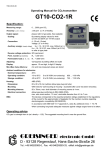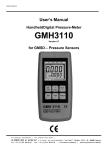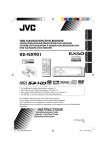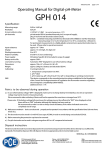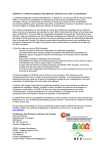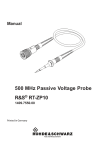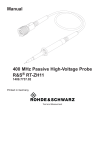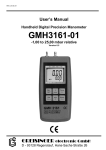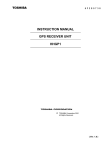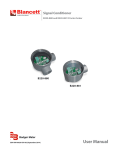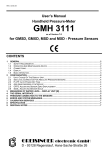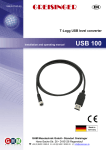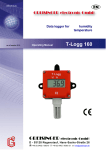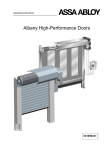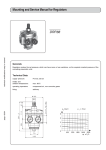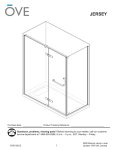Download GE - flowmeterflowsensor
Transcript
Z03.0.0X.6C-05 page 1 of 4 Manual for pH-electrodes (combination electrodes) GE ... Intended use The safety requirements (see below) have to be observed. The pH electrodes must be used only according to its intended purpose and under suitable conditions. The electrodes must be operated with suitable measuring devices and be calibrated before first use and afterwards in regular intervals. The life-time and accuracy of the electrodes depends on adequate selection as well as on proper handling. Please consider therefore the chapters “Choose the right electrode”, “Measuring and storing” and “Maintenance”. Use the device carefully and according to its technical data (do not throw it, strike it, etc.). Protect the device from dirt. Design In most cases so-called combination electrodes are used. That means that all needed elements are integrated in a single electrode (including reference electrode). Sometimes even a temperature sensor is integrated. The picture on the right shows an electrode without temperature sensor. There are several design types for the diaphragm, but generally said it is the connection between electrolyte and the measured solution. A blockade or soiling of the diaphragm is often the reason for the electrodes idleness and erratic behavior. The glass membrane has to be treated with care. The hydrated gel layer forms on the surface of the glass membrane, which is of highest importance for the measurement. The electrode has to be kept wet to preserve the hydrated gel layer (see below). Safety regulations: This device was designed and tested according to the safety regulations for electronic measuring devices. Faultless operation and reliability in operation of the measuring device can only be assured if general safety measures and the devices specific safety regulation mentioned in this user manual are considered. 1. Faultless operation and reliability in operation of the measuring device can only be assured if the device is used within the climatic conditions specified in the chapter “Specifications“. 3. When connecting the device to other devices the interconnection has to be designed most thoroughly, as internal connections in third-party devices (e.g. connection of ground with protective earth) may lead to undesired voltage potentials that can affect the connected devices, could damage them or even may destruct the devices. 4. The device must be switched off and must be marked against using again, in case of obvious malfunctions of the device which are e.g.: - - visible damage. the device is not working as prescribed. storing the device under inappropriate conditions for longer time. In case of doubt the device should be sent to the manufacturer for repairing or servicing. 5. Attention: Do NOT use this product as safety or emergency stopping device, or in any other application where failure of the product could result in personal injury or material damage. Failure to comply with these instructions could result in death or serious injury and material damage. 6. The electrodes contain 3 molar KCL (GE103: 1mol/l KNO3), which is acidly. First-Aid-provisions After contact with skin: clean with sufficient water. After contact with eyes: rinse opened eye with sufficient water, contact oculist After swallowing: drink much water. If feeling sick, contact doctor. 7. Attention! The electrodes contain glass. If the pH-electrode is damaged please abolish the medium being measured! If swallowed gullet and gastrointestinal tract could be injured. PRC Technologies Corp., Ltd. Tel : 02-932-1711-3 Fax : 02-530-1731 Email : [email protected] GHM Messtechnik GmbH - Standort Greisinger Hans-Sachs-Str. 26 • D-93128 Regenstauf +49 (0) 9402 / 9383-0 +49 (0) 9402 / 9383-33 [email protected] Z03.0.0X.6C-05 page 2 of 4 Specifications: Type Description Operating range Pressure low Cost pH-electrode pH 2-12, 0..60°C > 200 µS/cm pressureless standard pH-electrode pH 0-14, 0..80°C > 100 µS/cm pressureless injection pH-electrode pH 2-11, 0..60°C > 100 µS/cm pressureless pH 0-14, 0..80°C > 200 µS/cm pressureless special grinding GE 104 BNC pH-electrode pH 2-14, 0..80°C > 20 µS/cm pressureless GE 106 pH 0-14, 0..80°C > 100 µS/cm pressureless pH 0-14, 0..80°C > 200 µS/cm max 6 bar GE 014 GE 014 BNC GE 100 GE 100 BNC GE 101 GE 101 BNC GE 103 double chamber GE 103 BNC pH-electrode GE 104 GE 106 BNC GE 107 pH-electrode for VE water pH-electrode with int. Pt1000 sensor GE 108 Reference electrolyte 3mol/l KCl 3mol/l KCl 3mol/l KCl 3mol/l KCl 1mol/l KNO3 3mol/l KCl 3mol/l KCl 3mol/l KCl (gel) max 6 bar standard pH-electrode, GE 108 BNC pressure resistant GE 108 S7 pH 0-14, 0..80°C > 100 µS/cm Diaphragm type Tube /Membran shape Connection Cable Notes Cinch 1m 2xceramic / sphere plastic approx. Ø12x110 mm 1m 2xceramic / sphere plastic approx. Ø12x120 mm 1m 2xceramic / cone glass approx. Ø12x120 mm 1m 2xceramic / sphere plastic approx. Ø12x120 mm grinding / cylinder glass approx. Ø12x120 mm, Kopf ca. Ø6x30 mm 3xceramic / sphere plastic approx. Ø12x120 mm 2xceramic / cylinder plastic approx. Ø12x120 mm 2xceramic / cylinder plastic approx. Ø12x120 mm BNC Cinch BNCCinch BNC Cinch BNC Cinch 1m BNC Cinch moveable joint, easy-to-clean 1m BNC DIN and 4mm banana 2m Cinch 2m 3mol/l KCl (gel) BNC 2m S7 connection - *) pressure resistant up to 6 bar with PG13.5 thread pressure resistant up to 6 bar with PG13.5 thread GE 109 pH-electrode with int. Pt100 sensor pH 2-11, 0..60°C > 100 µS/cm max 6 bar 3mol/l KCl (gel) BNC und MiniDIN 2m pressure resistant up to 6 bar 2xceramic / cylinder plastic approx. Ø12x120 mm GE 117 pH-electrode with int. Pt1000 sensor pH 2-11, 0..60°C > 100 µS/cm max 6 bar 3mol/l KCl (gel) BNC and 4mm banana 2m pressure resistant up to 6 bar with PG13.5 thread 2xceramic / cylinder plastic approx. Ø12x120 mm pH 0-14, 0..60°C > 200 µS/cm Cinch 1m injection pH-electrode 2xceramic / cone plastic approx. Ø22x110 mm with injection tip approx. Ø13x60 GE 125 pH-electrode with int. Pt1000 sensor pH 0-14, 0-70°C > 200 µS/cm water-proof IP 67 incl. plug 1xceramic / cylinder plastic approx. Ø12x120 mm GE 151 pH-electrode for difficult pH 0-14, -5..80°C pressureless > 100 µS/cm alkali resistant 1xceramic / cylinder glass approx.Ø12x120 mm up to 130°C / 15 bar with 3xceramic / sphere PG13.5 thread glass approx. Ø12x120 mm GE 120 GE 120 BNC GE 151 BNC measurement conditions GE 170 GE 173 pressureless pressureless Ag/AgCl (gel) 3mol/l KCl (gel) 3mol/l KCl BNC BNC and 4mm banana 2m Cinch 1m BNC pH-electrode for extreme pH 0-14,0..130°C max 15bar measurement conditions > 100 µS/cm 3mol/l KCl (gel) S7 connection - *) max 6 bar 3mol/l KCl (gel) Cinch 2m special grinding GE 173 BNC pH-electrode pH 0-14, 0..80°C > 50 µS/cm BNC incl. screwable cutting blade Pressure resistant up to 6 bar with PG13.5 thread grinding / cylinder *) Note: cable GEAK-2S7-BNC or GEAK-5S7-BNC is needed for connection S7 GHM Messtechnik GmbH • Standort Greisinger • Hans-Sachs-Str. 26 • D-93128 Regenstauf +49 (0) 9402 / 9383-0 +49 (0) 9402 / 9383-33 [email protected] glass approx. Ø12x120 mm, head approx. Ø6x30 mm Z03.0.0X.6C-05 page 3 of 4 Choose the right electrode Aquarium water Beverages Cosmetics Drinking water Emulsions Fish farming Food sample Galvanic baths Low-ion media (Rain water, some aquariums, VE water) On-site measurements Photo laboratory Process chemistry Sea water Sewage Soil testings Suspensions Swimming pool water Water-based lacquers GE 014 X GE 100 X GE 101 GE 103 GE 104 GE 106 X GE 107 X GE 108 X GE 109 X GE 117 X GE 120 GE 125 X X X X X X X X X X GE 151 X X GE 170 GE 173 X X X X X X X X X X X X X X X X X X X X X X X X X X X X X X X X X X X X X X X X X X X X X X X X X General All electrodes are delivered checked and ready for measuring. The warranty period is 12 months for appropriate treating. pH-electrodes are wearing parts and have to be exchanged when the demanded values are not complying with, even after thoroughly cleaning the electrode and regenerating it, depending on chemical and mechanical strain. When using please consider that different substances in aqueous solution may affect glass and that chemicals may react with the KCl solution in the electrode and could block the diaphragm. Examples: - protein-containing dilutions, as used in medicinal and biological measuring, the protein could be denatured by the KCl solution - coagulated lacquers - solutions containing higher concentration of silver-ions Other problems could happen when measuring ion-depleted and solvent-containing mediums. Substances that deposit on the diaphragm, influence the measuring and have to be removed regularly. This can be done with the help of e.g. automatic-cleaning-facilities. The lifetime of the electrodes is normally more than 12 month and can be prolonged to more than 2 years by good maintenance. However, accurate values cannot be stated as they depend on the specific application. Extreme pH values and high temperatures accelerate the aging process. Measuring and storing The pH-electrodes have been tested and have been subordinated strict quality controls in all manufacturing-steps To keep the optimum efficiency and accuracy for a long time take care of the following points: Remove the storing protection-cap and rinse the shaft and pH-glass-diaphragm with distilled water. Important! The pH-glass-diaphragm has to be kept wet. When not in use the electrode must be stored in 3 mol/l KCl solution. (GE 103 in 1 mol/l KNO3). If the pH-glass-diaphragm dried out, the performance and the responsiveness are affected. To re-moisten the electrode store it in 3 mol/l KCl solution for 24 hours (GE 103 1 mol/l KNO 3). A longer storage of a combination-electrode or a reference-electrode in distillated water will deplete them of KCl. Please refill KCl-electrolyte (saturated or 3 mol) in time Do not touch the glass-diaphragm! Damages on the surface and attrition affect the performance negatively and might even destroy the electrode. Before usage perform a visual check of the pH-electrode. If there are air-bubbles in the pH-glass-diaphragm or the outer reference-electrode you can get them out by shaking the electrode downward (like handling a quicksilverfibre-thermometer) GHM Messtechnik GmbH • Standort Greisinger • Hans-Sachs-Str. 26 • D-93128 Regenstauf +49 (0) 9402 / 9383-0 +49 (0) 9402 / 9383-33 [email protected] Z03.0.0X.6C-05 page 4 of 4 For electrodes with liquid electrolytes: For continuous flow of electrolyte the cap sleeve made of rubber, that covers the refill opening, has to be removed before measurements. The opening has to be closed for storage in order to prevent running down. The level of the electrolyte should be over the level of the measured medium. This ensures stable measuring values and reduces pollution of the diaphragm and reference electrolyte. Take care that the diaphragm fully contacts the media you want to measure. Minimum depth for e.g. GE 100 20 mm, maximum 80 mm Keep cable and plug of the electrode always clean and dry. Otherwise the electric insulation will be lost and consequently measuring errors or other subsequent errors might occur. The calibration (adjustment) of the measurement chain (single-rod or measurement and reference electrode) has to be performed according to the device manufacturer. The “asymmetry” is adjusted with help of an buffer solution with a value at the chain’s zero point (e.g. pH 7.0). The “slope” is adjusted with help of a second buffer solution, whose pH value should match the expected measuring range (e.g. pH 4.0; pH 10.0; pH 12.0), but at least 2 pH units different from the first value. The electrode has to be stored in dry rooms at temperatures between 10°C to 30°C. Below –5°C the electrode might be damaged because of freezing of the electrolyte. Our pH-electrodes can be used at angles of 90° ±45° to the horizontal. Calibration The electrodes have to be calibrated (adjusted) in regular intervals. The length of the intervals depends on the accuracy requirements, the application and the electrode. If asymmetry or slope cannot be adjusted any longer, it’s a sign that a) the electrode is exhausted and has to be exchanged , or b) the electrode is polluted and has to be cleansed (see below), or c) the buffer solution is exhausted (prepare new solution). Prepared buffer solution have a limited life time (about 1 month) when using/calibrating it thoroughly (no procrastination of buffer solution residua from one solution to an other one through cleaning and drying the electrode not enough) Buffer-capsules have no lifetime limitations, therefor we recommend keeping a sufficient number of them in stock. pH 12 buffer capsules (white) have to be stored in an exsiccator or stored together with drying agent. The electrolyte (3mol/l KCl) should always be available for refilling, it is also recommended to keep enough in stock. As an alternative to the buffer capsules the PHL buffer solutions are available. They are stored in practical 250 ml dosage bottles and are ready-to-use (keep the best-before at the buffer solutions in mind). The electrolyte (mostly 3 mol/l KCl) should be always available for refilling, too. (e.g. contained in working and calibration set GAK 1400). Maintenance For electrodes with liquid electrolyte: Check level of reference electrolyte and, if necessary, refill 3 mol/l KCl solution with help of an syringe or pipette. Crystallization of the 3 mol/l KCl (3 molar KCl) is inevitable! Crystallized KCl on the protection-cap and the breechcollar can be removed with fingernails or a wet cloth. This is no defect or a reason for reclamation. Contaminated electrodes have to be cleaned. The suitable cleaning agents for the pH-glass-diaphragm are given in the table below. Mechanical cleansing should be avoided as this might damage the electrode permanently. Therefore a chemical cleansing is preferable. Standard cleaning: Put electrode into cleaning solution GRL100 (0,1 molar HCl with Pepsin, *) for 10 min. contamination general deposits inorganic coatings metallic compounds oil, fat biological coatings with protein resin-lignin extremely resistant deposits cleaning agent mild washing agent common fluids for glass cleaning 1 mol/l HCl solution special cleaning agents or solvent pepsin-enzyme in 0.1 molar HCl-dilution (GRL100 *) acetone hydrogen peroxide, sodium hypochloride . The distinct materials of the electrode have to be considered when choosing the cleaning agent. E.g. electrodes with plastics shaft must not be cleaned with solvents. In case of doubt please contact the manufacturer for further advice. The same has to be considered when using aggressive or other, non water based agents! *) e.g. included in working and calibration set GAK1400. Disposal: Exhausted pH-electrodes must be disposed via special refuse. When delivering exhausted electrodes from our product range, free for us (sufficient post paid), we will dispose them for free. GHM Messtechnik GmbH • Standort Greisinger • Hans-Sachs-Str. 26 • D-93128 Regenstauf +49 (0) 9402 / 9383-0 +49 (0) 9402 / 9383-33 [email protected]




